Analyzing Strategic HRM: Practices, Approaches, and Challenges
VerifiedAdded on 2021/02/20
|10
|3881
|29
Essay
AI Summary
This essay delves into the intricacies of strategic human resource management (HRM), exploring the advantages and disadvantages of both the best practice and best fit approaches. It critically assesses how HRM practices must adapt as an organization progresses through its life cycle, encompassing stages from job description and selection to training, performance management, and career development. The essay identifies key challenges faced by HRM practitioners at each stage of the organizational life cycle, emphasizing the importance of aligning HR strategies with business goals for competitive advantage and organizational success. It highlights the significance of employee selection, training, and communication in achieving organizational objectives. The analysis also considers the role of HR managers in building core competencies and adapting to organizational changes, underscoring the need for a strategic and integrated approach to HRM for long-term success. The essay concludes by reinforcing the importance of choosing HR practices that align with the organizational culture and the value of employees as a key resource.
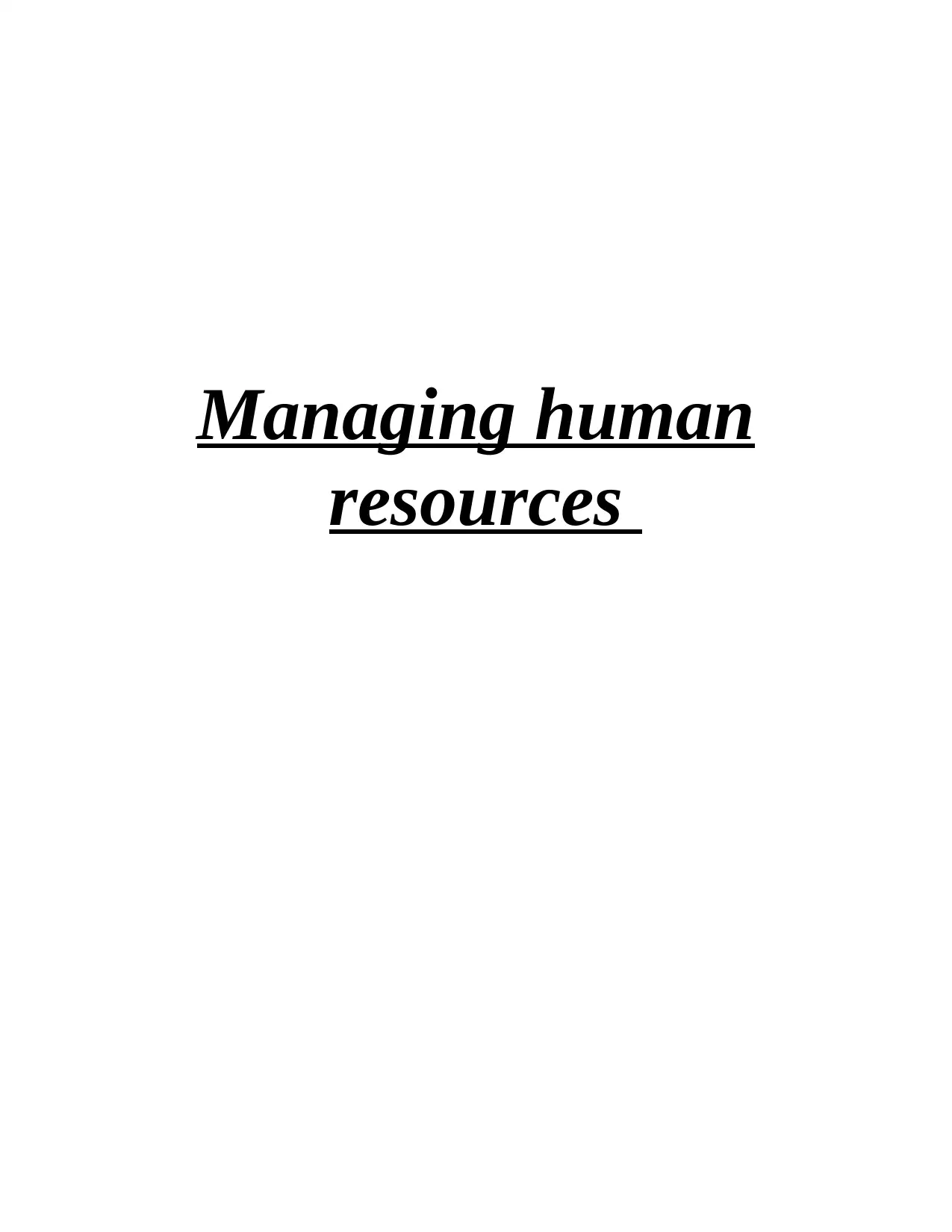
Managing human
resources
resources
Paraphrase This Document
Need a fresh take? Get an instant paraphrase of this document with our AI Paraphraser
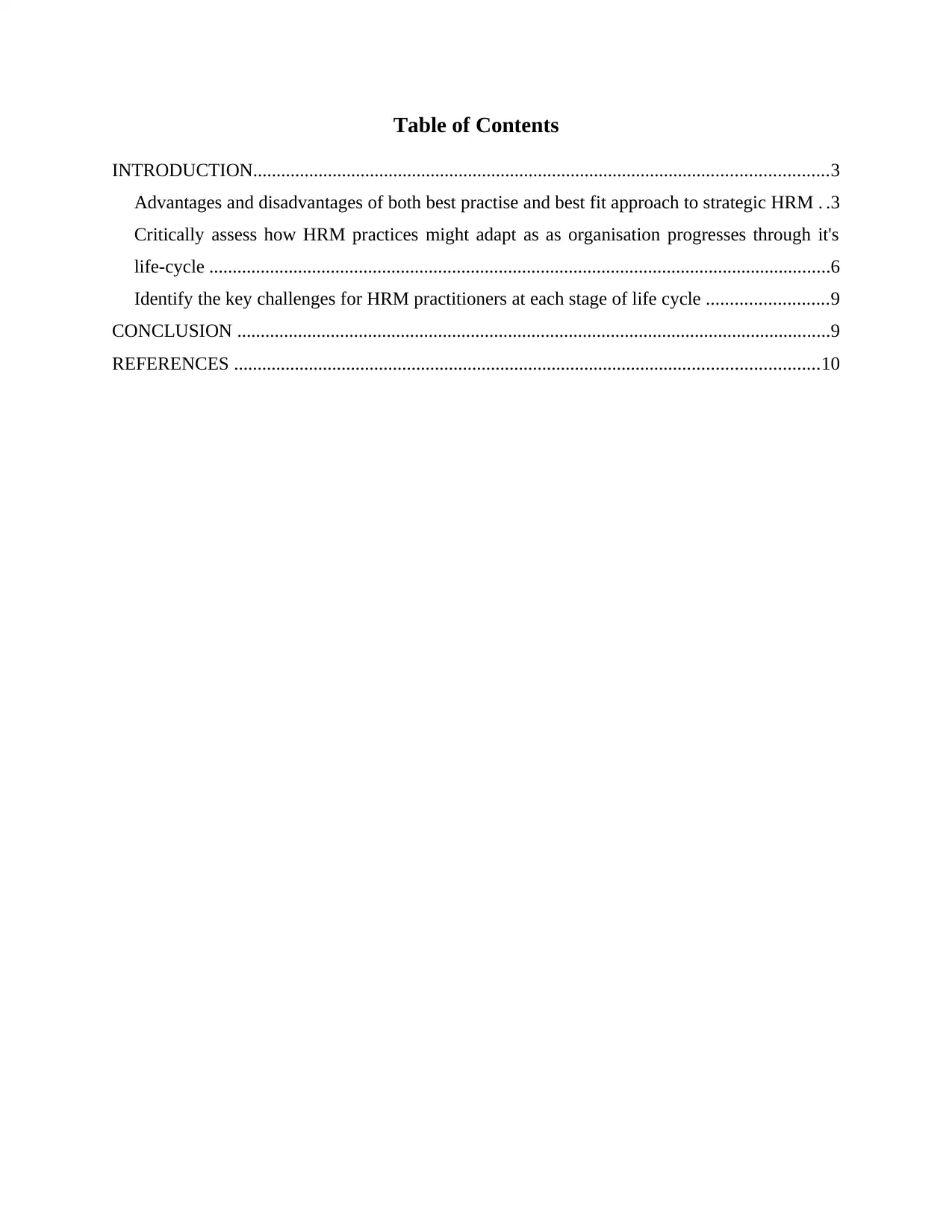
Table of Contents
INTRODUCTION...........................................................................................................................3
Advantages and disadvantages of both best practise and best fit approach to strategic HRM . .3
Critically assess how HRM practices might adapt as as organisation progresses through it's
life-cycle .....................................................................................................................................6
Identify the key challenges for HRM practitioners at each stage of life cycle ..........................9
CONCLUSION ...............................................................................................................................9
REFERENCES .............................................................................................................................10
INTRODUCTION...........................................................................................................................3
Advantages and disadvantages of both best practise and best fit approach to strategic HRM . .3
Critically assess how HRM practices might adapt as as organisation progresses through it's
life-cycle .....................................................................................................................................6
Identify the key challenges for HRM practitioners at each stage of life cycle ..........................9
CONCLUSION ...............................................................................................................................9
REFERENCES .............................................................................................................................10
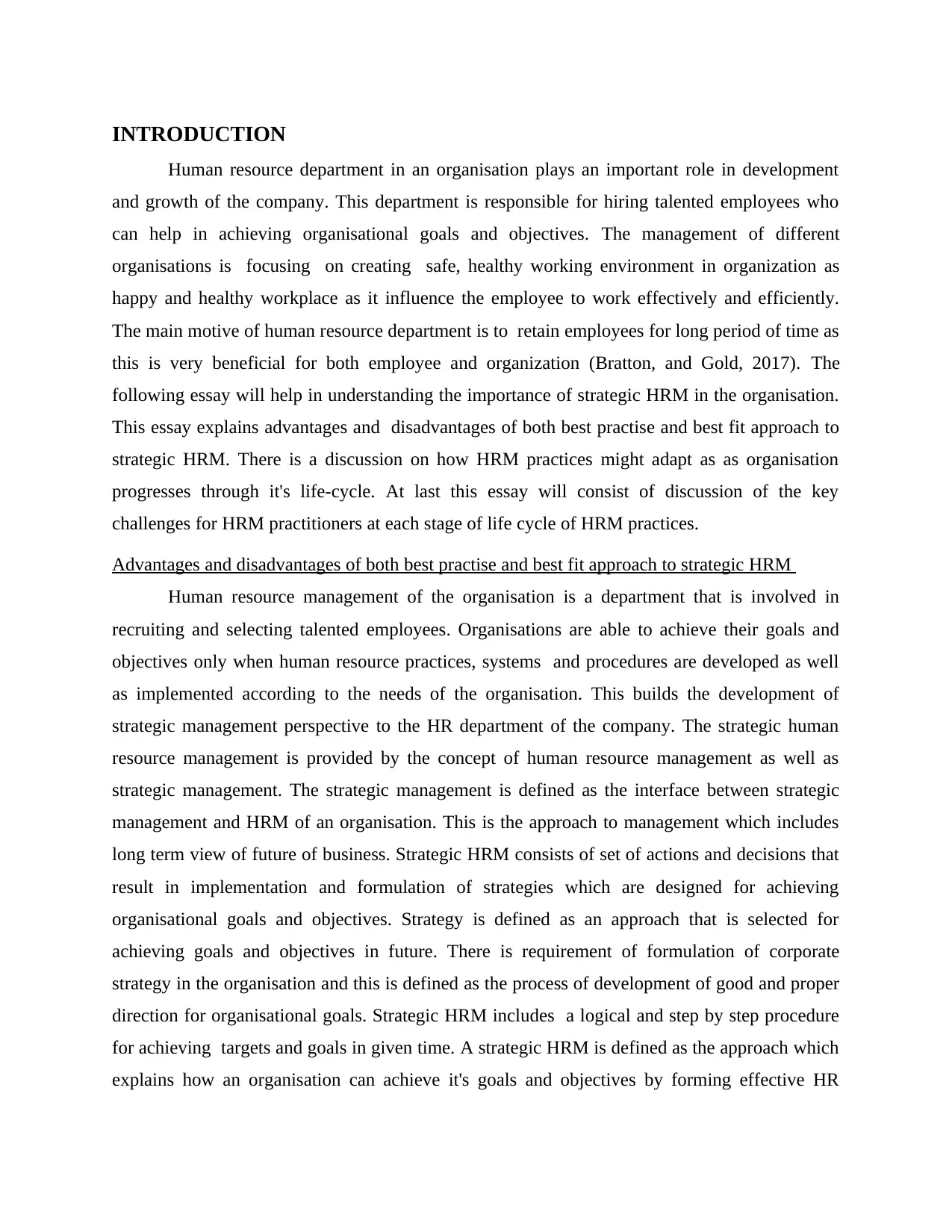
INTRODUCTION
Human resource department in an organisation plays an important role in development
and growth of the company. This department is responsible for hiring talented employees who
can help in achieving organisational goals and objectives. The management of different
organisations is focusing on creating safe, healthy working environment in organization as
happy and healthy workplace as it influence the employee to work effectively and efficiently.
The main motive of human resource department is to retain employees for long period of time as
this is very beneficial for both employee and organization (Bratton, and Gold, 2017). The
following essay will help in understanding the importance of strategic HRM in the organisation.
This essay explains advantages and disadvantages of both best practise and best fit approach to
strategic HRM. There is a discussion on how HRM practices might adapt as as organisation
progresses through it's life-cycle. At last this essay will consist of discussion of the key
challenges for HRM practitioners at each stage of life cycle of HRM practices.
Advantages and disadvantages of both best practise and best fit approach to strategic HRM
Human resource management of the organisation is a department that is involved in
recruiting and selecting talented employees. Organisations are able to achieve their goals and
objectives only when human resource practices, systems and procedures are developed as well
as implemented according to the needs of the organisation. This builds the development of
strategic management perspective to the HR department of the company. The strategic human
resource management is provided by the concept of human resource management as well as
strategic management. The strategic management is defined as the interface between strategic
management and HRM of an organisation. This is the approach to management which includes
long term view of future of business. Strategic HRM consists of set of actions and decisions that
result in implementation and formulation of strategies which are designed for achieving
organisational goals and objectives. Strategy is defined as an approach that is selected for
achieving goals and objectives in future. There is requirement of formulation of corporate
strategy in the organisation and this is defined as the process of development of good and proper
direction for organisational goals. Strategic HRM includes a logical and step by step procedure
for achieving targets and goals in given time. A strategic HRM is defined as the approach which
explains how an organisation can achieve it's goals and objectives by forming effective HR
Human resource department in an organisation plays an important role in development
and growth of the company. This department is responsible for hiring talented employees who
can help in achieving organisational goals and objectives. The management of different
organisations is focusing on creating safe, healthy working environment in organization as
happy and healthy workplace as it influence the employee to work effectively and efficiently.
The main motive of human resource department is to retain employees for long period of time as
this is very beneficial for both employee and organization (Bratton, and Gold, 2017). The
following essay will help in understanding the importance of strategic HRM in the organisation.
This essay explains advantages and disadvantages of both best practise and best fit approach to
strategic HRM. There is a discussion on how HRM practices might adapt as as organisation
progresses through it's life-cycle. At last this essay will consist of discussion of the key
challenges for HRM practitioners at each stage of life cycle of HRM practices.
Advantages and disadvantages of both best practise and best fit approach to strategic HRM
Human resource management of the organisation is a department that is involved in
recruiting and selecting talented employees. Organisations are able to achieve their goals and
objectives only when human resource practices, systems and procedures are developed as well
as implemented according to the needs of the organisation. This builds the development of
strategic management perspective to the HR department of the company. The strategic human
resource management is provided by the concept of human resource management as well as
strategic management. The strategic management is defined as the interface between strategic
management and HRM of an organisation. This is the approach to management which includes
long term view of future of business. Strategic HRM consists of set of actions and decisions that
result in implementation and formulation of strategies which are designed for achieving
organisational goals and objectives. Strategy is defined as an approach that is selected for
achieving goals and objectives in future. There is requirement of formulation of corporate
strategy in the organisation and this is defined as the process of development of good and proper
direction for organisational goals. Strategic HRM includes a logical and step by step procedure
for achieving targets and goals in given time. A strategic HRM is defined as the approach which
explains how an organisation can achieve it's goals and objectives by forming effective HR
⊘ This is a preview!⊘
Do you want full access?
Subscribe today to unlock all pages.

Trusted by 1+ million students worldwide
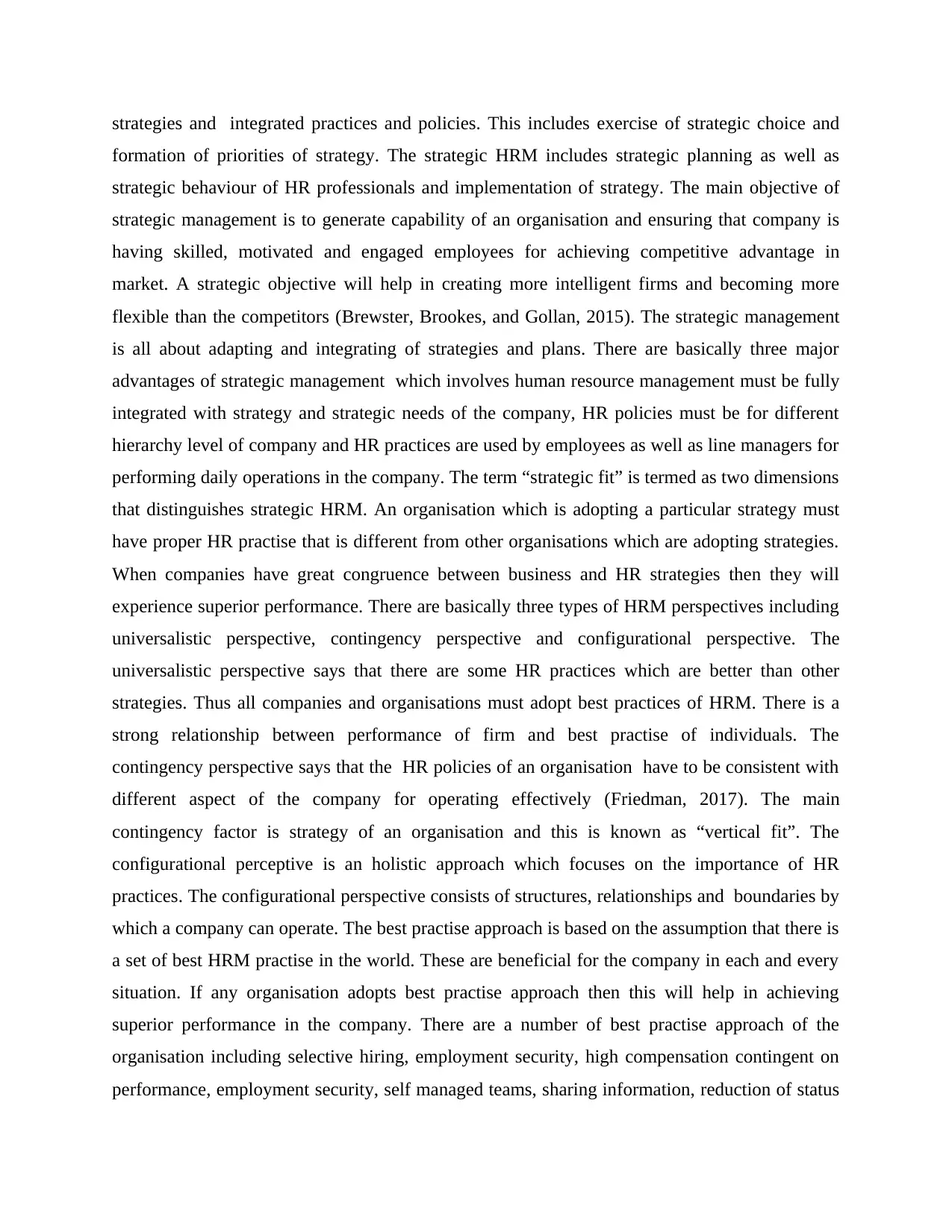
strategies and integrated practices and policies. This includes exercise of strategic choice and
formation of priorities of strategy. The strategic HRM includes strategic planning as well as
strategic behaviour of HR professionals and implementation of strategy. The main objective of
strategic management is to generate capability of an organisation and ensuring that company is
having skilled, motivated and engaged employees for achieving competitive advantage in
market. A strategic objective will help in creating more intelligent firms and becoming more
flexible than the competitors (Brewster, Brookes, and Gollan, 2015). The strategic management
is all about adapting and integrating of strategies and plans. There are basically three major
advantages of strategic management which involves human resource management must be fully
integrated with strategy and strategic needs of the company, HR policies must be for different
hierarchy level of company and HR practices are used by employees as well as line managers for
performing daily operations in the company. The term “strategic fit” is termed as two dimensions
that distinguishes strategic HRM. An organisation which is adopting a particular strategy must
have proper HR practise that is different from other organisations which are adopting strategies.
When companies have great congruence between business and HR strategies then they will
experience superior performance. There are basically three types of HRM perspectives including
universalistic perspective, contingency perspective and configurational perspective. The
universalistic perspective says that there are some HR practices which are better than other
strategies. Thus all companies and organisations must adopt best practices of HRM. There is a
strong relationship between performance of firm and best practise of individuals. The
contingency perspective says that the HR policies of an organisation have to be consistent with
different aspect of the company for operating effectively (Friedman, 2017). The main
contingency factor is strategy of an organisation and this is known as “vertical fit”. The
configurational perceptive is an holistic approach which focuses on the importance of HR
practices. The configurational perspective consists of structures, relationships and boundaries by
which a company can operate. The best practise approach is based on the assumption that there is
a set of best HRM practise in the world. These are beneficial for the company in each and every
situation. If any organisation adopts best practise approach then this will help in achieving
superior performance in the company. There are a number of best practise approach of the
organisation including selective hiring, employment security, high compensation contingent on
performance, employment security, self managed teams, sharing information, reduction of status
formation of priorities of strategy. The strategic HRM includes strategic planning as well as
strategic behaviour of HR professionals and implementation of strategy. The main objective of
strategic management is to generate capability of an organisation and ensuring that company is
having skilled, motivated and engaged employees for achieving competitive advantage in
market. A strategic objective will help in creating more intelligent firms and becoming more
flexible than the competitors (Brewster, Brookes, and Gollan, 2015). The strategic management
is all about adapting and integrating of strategies and plans. There are basically three major
advantages of strategic management which involves human resource management must be fully
integrated with strategy and strategic needs of the company, HR policies must be for different
hierarchy level of company and HR practices are used by employees as well as line managers for
performing daily operations in the company. The term “strategic fit” is termed as two dimensions
that distinguishes strategic HRM. An organisation which is adopting a particular strategy must
have proper HR practise that is different from other organisations which are adopting strategies.
When companies have great congruence between business and HR strategies then they will
experience superior performance. There are basically three types of HRM perspectives including
universalistic perspective, contingency perspective and configurational perspective. The
universalistic perspective says that there are some HR practices which are better than other
strategies. Thus all companies and organisations must adopt best practices of HRM. There is a
strong relationship between performance of firm and best practise of individuals. The
contingency perspective says that the HR policies of an organisation have to be consistent with
different aspect of the company for operating effectively (Friedman, 2017). The main
contingency factor is strategy of an organisation and this is known as “vertical fit”. The
configurational perceptive is an holistic approach which focuses on the importance of HR
practices. The configurational perspective consists of structures, relationships and boundaries by
which a company can operate. The best practise approach is based on the assumption that there is
a set of best HRM practise in the world. These are beneficial for the company in each and every
situation. If any organisation adopts best practise approach then this will help in achieving
superior performance in the company. There are a number of best practise approach of the
organisation including selective hiring, employment security, high compensation contingent on
performance, employment security, self managed teams, sharing information, reduction of status
Paraphrase This Document
Need a fresh take? Get an instant paraphrase of this document with our AI Paraphraser
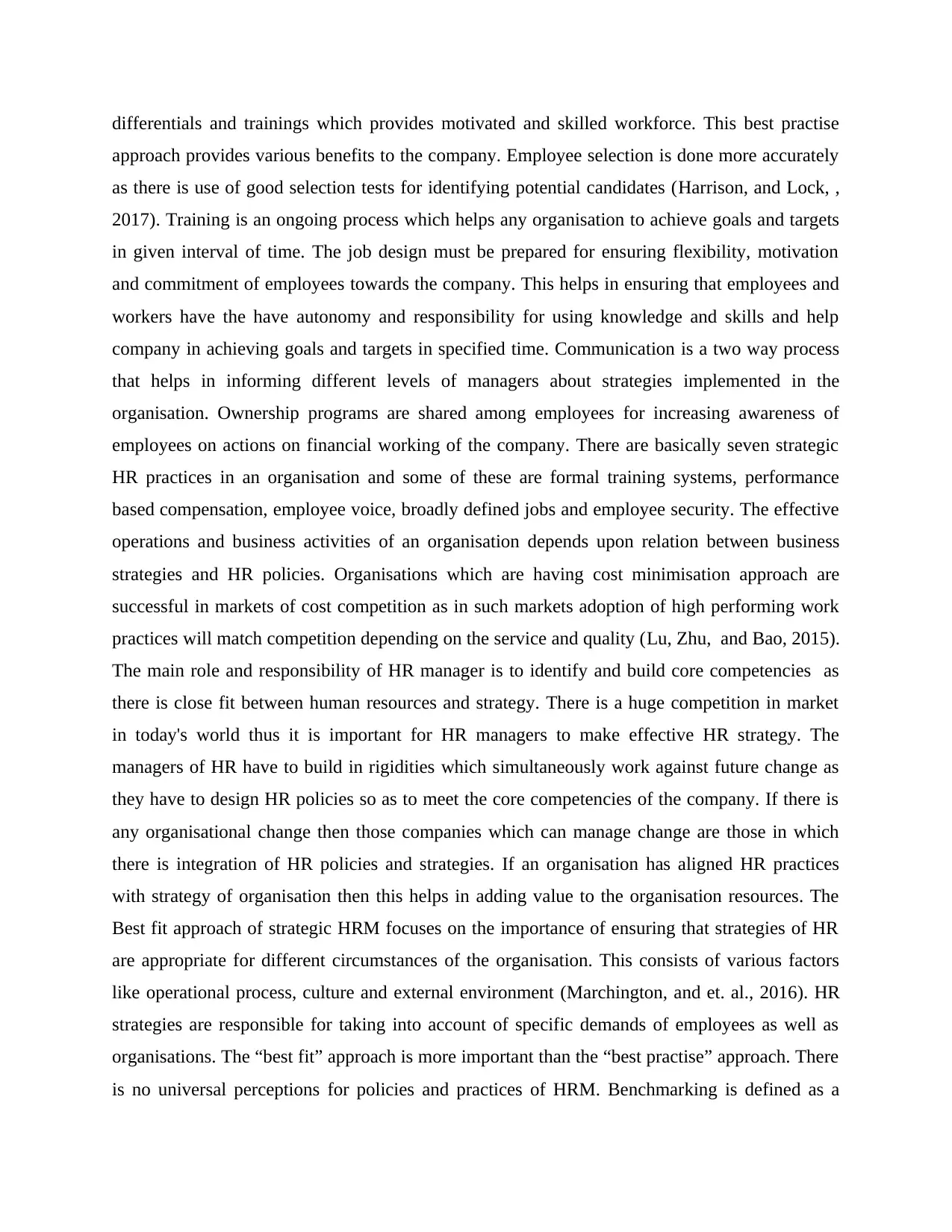
differentials and trainings which provides motivated and skilled workforce. This best practise
approach provides various benefits to the company. Employee selection is done more accurately
as there is use of good selection tests for identifying potential candidates (Harrison, and Lock, ,
2017). Training is an ongoing process which helps any organisation to achieve goals and targets
in given interval of time. The job design must be prepared for ensuring flexibility, motivation
and commitment of employees towards the company. This helps in ensuring that employees and
workers have the have autonomy and responsibility for using knowledge and skills and help
company in achieving goals and targets in specified time. Communication is a two way process
that helps in informing different levels of managers about strategies implemented in the
organisation. Ownership programs are shared among employees for increasing awareness of
employees on actions on financial working of the company. There are basically seven strategic
HR practices in an organisation and some of these are formal training systems, performance
based compensation, employee voice, broadly defined jobs and employee security. The effective
operations and business activities of an organisation depends upon relation between business
strategies and HR policies. Organisations which are having cost minimisation approach are
successful in markets of cost competition as in such markets adoption of high performing work
practices will match competition depending on the service and quality (Lu, Zhu, and Bao, 2015).
The main role and responsibility of HR manager is to identify and build core competencies as
there is close fit between human resources and strategy. There is a huge competition in market
in today's world thus it is important for HR managers to make effective HR strategy. The
managers of HR have to build in rigidities which simultaneously work against future change as
they have to design HR policies so as to meet the core competencies of the company. If there is
any organisational change then those companies which can manage change are those in which
there is integration of HR policies and strategies. If an organisation has aligned HR practices
with strategy of organisation then this helps in adding value to the organisation resources. The
Best fit approach of strategic HRM focuses on the importance of ensuring that strategies of HR
are appropriate for different circumstances of the organisation. This consists of various factors
like operational process, culture and external environment (Marchington, and et. al., 2016). HR
strategies are responsible for taking into account of specific demands of employees as well as
organisations. The “best fit” approach is more important than the “best practise” approach. There
is no universal perceptions for policies and practices of HRM. Benchmarking is defined as a
approach provides various benefits to the company. Employee selection is done more accurately
as there is use of good selection tests for identifying potential candidates (Harrison, and Lock, ,
2017). Training is an ongoing process which helps any organisation to achieve goals and targets
in given interval of time. The job design must be prepared for ensuring flexibility, motivation
and commitment of employees towards the company. This helps in ensuring that employees and
workers have the have autonomy and responsibility for using knowledge and skills and help
company in achieving goals and targets in specified time. Communication is a two way process
that helps in informing different levels of managers about strategies implemented in the
organisation. Ownership programs are shared among employees for increasing awareness of
employees on actions on financial working of the company. There are basically seven strategic
HR practices in an organisation and some of these are formal training systems, performance
based compensation, employee voice, broadly defined jobs and employee security. The effective
operations and business activities of an organisation depends upon relation between business
strategies and HR policies. Organisations which are having cost minimisation approach are
successful in markets of cost competition as in such markets adoption of high performing work
practices will match competition depending on the service and quality (Lu, Zhu, and Bao, 2015).
The main role and responsibility of HR manager is to identify and build core competencies as
there is close fit between human resources and strategy. There is a huge competition in market
in today's world thus it is important for HR managers to make effective HR strategy. The
managers of HR have to build in rigidities which simultaneously work against future change as
they have to design HR policies so as to meet the core competencies of the company. If there is
any organisational change then those companies which can manage change are those in which
there is integration of HR policies and strategies. If an organisation has aligned HR practices
with strategy of organisation then this helps in adding value to the organisation resources. The
Best fit approach of strategic HRM focuses on the importance of ensuring that strategies of HR
are appropriate for different circumstances of the organisation. This consists of various factors
like operational process, culture and external environment (Marchington, and et. al., 2016). HR
strategies are responsible for taking into account of specific demands of employees as well as
organisations. The “best fit” approach is more important than the “best practise” approach. There
is no universal perceptions for policies and practices of HRM. Benchmarking is defined as a
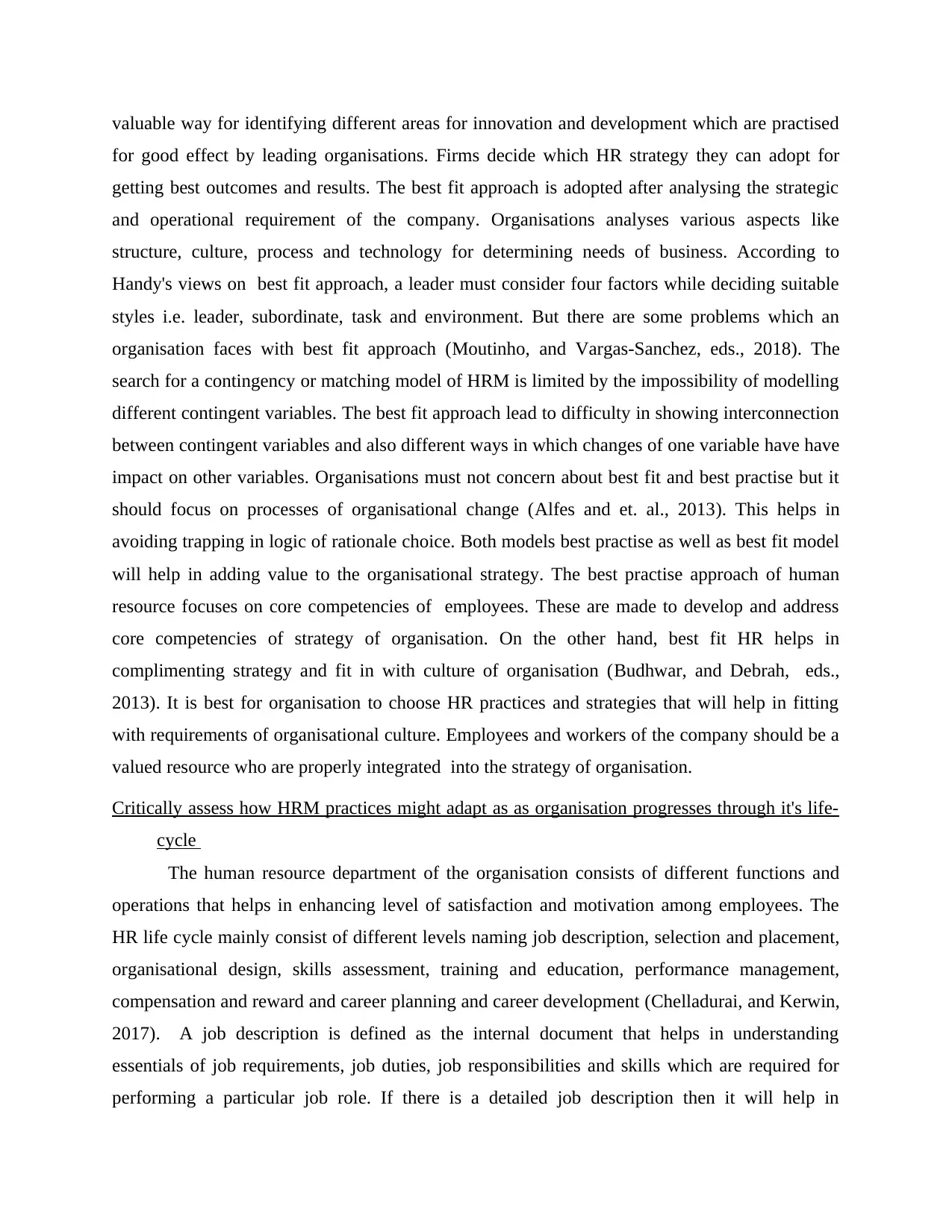
valuable way for identifying different areas for innovation and development which are practised
for good effect by leading organisations. Firms decide which HR strategy they can adopt for
getting best outcomes and results. The best fit approach is adopted after analysing the strategic
and operational requirement of the company. Organisations analyses various aspects like
structure, culture, process and technology for determining needs of business. According to
Handy's views on best fit approach, a leader must consider four factors while deciding suitable
styles i.e. leader, subordinate, task and environment. But there are some problems which an
organisation faces with best fit approach (Moutinho, and Vargas-Sanchez, eds., 2018). The
search for a contingency or matching model of HRM is limited by the impossibility of modelling
different contingent variables. The best fit approach lead to difficulty in showing interconnection
between contingent variables and also different ways in which changes of one variable have have
impact on other variables. Organisations must not concern about best fit and best practise but it
should focus on processes of organisational change (Alfes and et. al., 2013). This helps in
avoiding trapping in logic of rationale choice. Both models best practise as well as best fit model
will help in adding value to the organisational strategy. The best practise approach of human
resource focuses on core competencies of employees. These are made to develop and address
core competencies of strategy of organisation. On the other hand, best fit HR helps in
complimenting strategy and fit in with culture of organisation (Budhwar, and Debrah, eds.,
2013). It is best for organisation to choose HR practices and strategies that will help in fitting
with requirements of organisational culture. Employees and workers of the company should be a
valued resource who are properly integrated into the strategy of organisation.
Critically assess how HRM practices might adapt as as organisation progresses through it's life-
cycle
The human resource department of the organisation consists of different functions and
operations that helps in enhancing level of satisfaction and motivation among employees. The
HR life cycle mainly consist of different levels naming job description, selection and placement,
organisational design, skills assessment, training and education, performance management,
compensation and reward and career planning and career development (Chelladurai, and Kerwin,
2017). A job description is defined as the internal document that helps in understanding
essentials of job requirements, job duties, job responsibilities and skills which are required for
performing a particular job role. If there is a detailed job description then it will help in
for good effect by leading organisations. Firms decide which HR strategy they can adopt for
getting best outcomes and results. The best fit approach is adopted after analysing the strategic
and operational requirement of the company. Organisations analyses various aspects like
structure, culture, process and technology for determining needs of business. According to
Handy's views on best fit approach, a leader must consider four factors while deciding suitable
styles i.e. leader, subordinate, task and environment. But there are some problems which an
organisation faces with best fit approach (Moutinho, and Vargas-Sanchez, eds., 2018). The
search for a contingency or matching model of HRM is limited by the impossibility of modelling
different contingent variables. The best fit approach lead to difficulty in showing interconnection
between contingent variables and also different ways in which changes of one variable have have
impact on other variables. Organisations must not concern about best fit and best practise but it
should focus on processes of organisational change (Alfes and et. al., 2013). This helps in
avoiding trapping in logic of rationale choice. Both models best practise as well as best fit model
will help in adding value to the organisational strategy. The best practise approach of human
resource focuses on core competencies of employees. These are made to develop and address
core competencies of strategy of organisation. On the other hand, best fit HR helps in
complimenting strategy and fit in with culture of organisation (Budhwar, and Debrah, eds.,
2013). It is best for organisation to choose HR practices and strategies that will help in fitting
with requirements of organisational culture. Employees and workers of the company should be a
valued resource who are properly integrated into the strategy of organisation.
Critically assess how HRM practices might adapt as as organisation progresses through it's life-
cycle
The human resource department of the organisation consists of different functions and
operations that helps in enhancing level of satisfaction and motivation among employees. The
HR life cycle mainly consist of different levels naming job description, selection and placement,
organisational design, skills assessment, training and education, performance management,
compensation and reward and career planning and career development (Chelladurai, and Kerwin,
2017). A job description is defined as the internal document that helps in understanding
essentials of job requirements, job duties, job responsibilities and skills which are required for
performing a particular job role. If there is a detailed job description then it will help in
⊘ This is a preview!⊘
Do you want full access?
Subscribe today to unlock all pages.

Trusted by 1+ million students worldwide
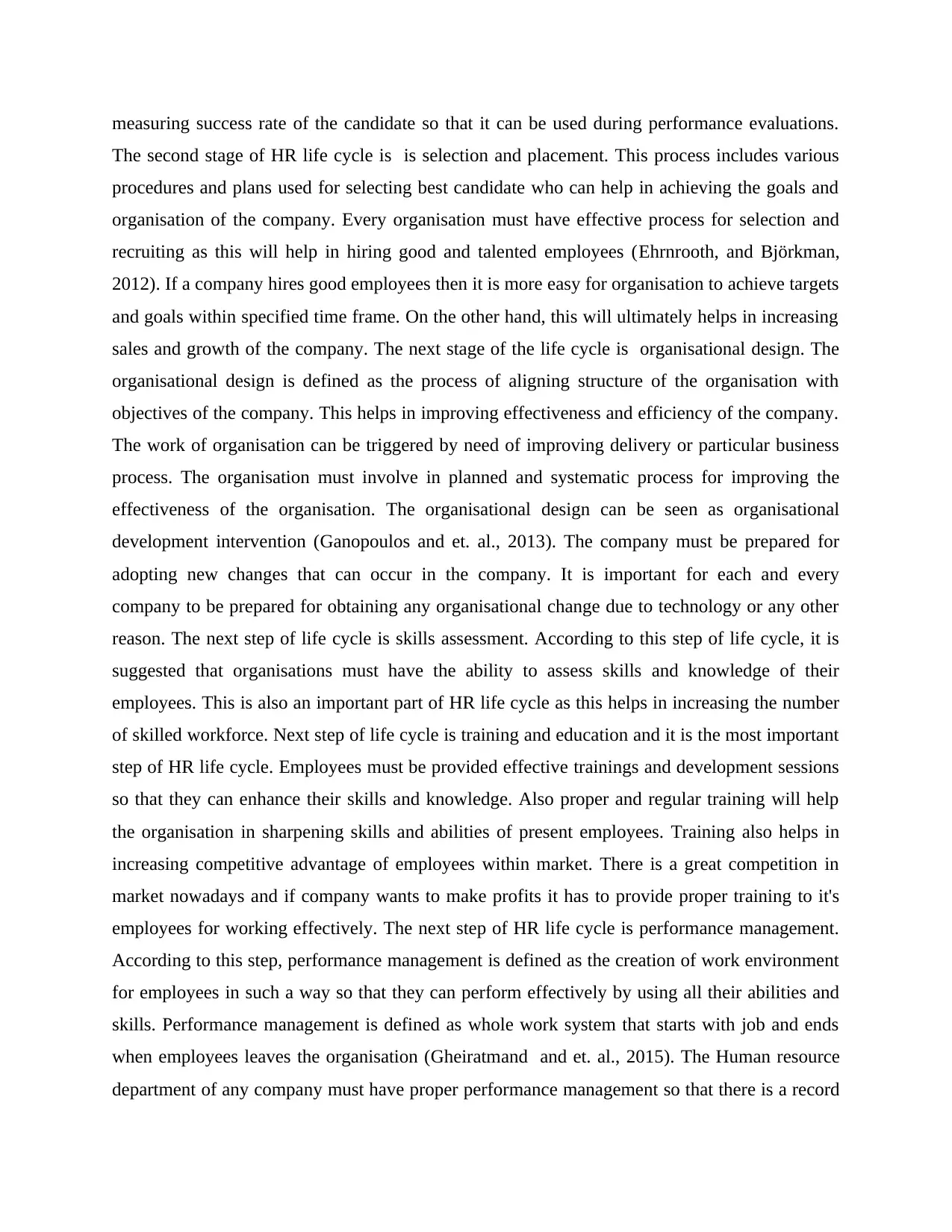
measuring success rate of the candidate so that it can be used during performance evaluations.
The second stage of HR life cycle is is selection and placement. This process includes various
procedures and plans used for selecting best candidate who can help in achieving the goals and
organisation of the company. Every organisation must have effective process for selection and
recruiting as this will help in hiring good and talented employees (Ehrnrooth, and Björkman,
2012). If a company hires good employees then it is more easy for organisation to achieve targets
and goals within specified time frame. On the other hand, this will ultimately helps in increasing
sales and growth of the company. The next stage of the life cycle is organisational design. The
organisational design is defined as the process of aligning structure of the organisation with
objectives of the company. This helps in improving effectiveness and efficiency of the company.
The work of organisation can be triggered by need of improving delivery or particular business
process. The organisation must involve in planned and systematic process for improving the
effectiveness of the organisation. The organisational design can be seen as organisational
development intervention (Ganopoulos and et. al., 2013). The company must be prepared for
adopting new changes that can occur in the company. It is important for each and every
company to be prepared for obtaining any organisational change due to technology or any other
reason. The next step of life cycle is skills assessment. According to this step of life cycle, it is
suggested that organisations must have the ability to assess skills and knowledge of their
employees. This is also an important part of HR life cycle as this helps in increasing the number
of skilled workforce. Next step of life cycle is training and education and it is the most important
step of HR life cycle. Employees must be provided effective trainings and development sessions
so that they can enhance their skills and knowledge. Also proper and regular training will help
the organisation in sharpening skills and abilities of present employees. Training also helps in
increasing competitive advantage of employees within market. There is a great competition in
market nowadays and if company wants to make profits it has to provide proper training to it's
employees for working effectively. The next step of HR life cycle is performance management.
According to this step, performance management is defined as the creation of work environment
for employees in such a way so that they can perform effectively by using all their abilities and
skills. Performance management is defined as whole work system that starts with job and ends
when employees leaves the organisation (Gheiratmand and et. al., 2015). The Human resource
department of any company must have proper performance management so that there is a record
The second stage of HR life cycle is is selection and placement. This process includes various
procedures and plans used for selecting best candidate who can help in achieving the goals and
organisation of the company. Every organisation must have effective process for selection and
recruiting as this will help in hiring good and talented employees (Ehrnrooth, and Björkman,
2012). If a company hires good employees then it is more easy for organisation to achieve targets
and goals within specified time frame. On the other hand, this will ultimately helps in increasing
sales and growth of the company. The next stage of the life cycle is organisational design. The
organisational design is defined as the process of aligning structure of the organisation with
objectives of the company. This helps in improving effectiveness and efficiency of the company.
The work of organisation can be triggered by need of improving delivery or particular business
process. The organisation must involve in planned and systematic process for improving the
effectiveness of the organisation. The organisational design can be seen as organisational
development intervention (Ganopoulos and et. al., 2013). The company must be prepared for
adopting new changes that can occur in the company. It is important for each and every
company to be prepared for obtaining any organisational change due to technology or any other
reason. The next step of life cycle is skills assessment. According to this step of life cycle, it is
suggested that organisations must have the ability to assess skills and knowledge of their
employees. This is also an important part of HR life cycle as this helps in increasing the number
of skilled workforce. Next step of life cycle is training and education and it is the most important
step of HR life cycle. Employees must be provided effective trainings and development sessions
so that they can enhance their skills and knowledge. Also proper and regular training will help
the organisation in sharpening skills and abilities of present employees. Training also helps in
increasing competitive advantage of employees within market. There is a great competition in
market nowadays and if company wants to make profits it has to provide proper training to it's
employees for working effectively. The next step of HR life cycle is performance management.
According to this step, performance management is defined as the creation of work environment
for employees in such a way so that they can perform effectively by using all their abilities and
skills. Performance management is defined as whole work system that starts with job and ends
when employees leaves the organisation (Gheiratmand and et. al., 2015). The Human resource
department of any company must have proper performance management so that there is a record
Paraphrase This Document
Need a fresh take? Get an instant paraphrase of this document with our AI Paraphraser
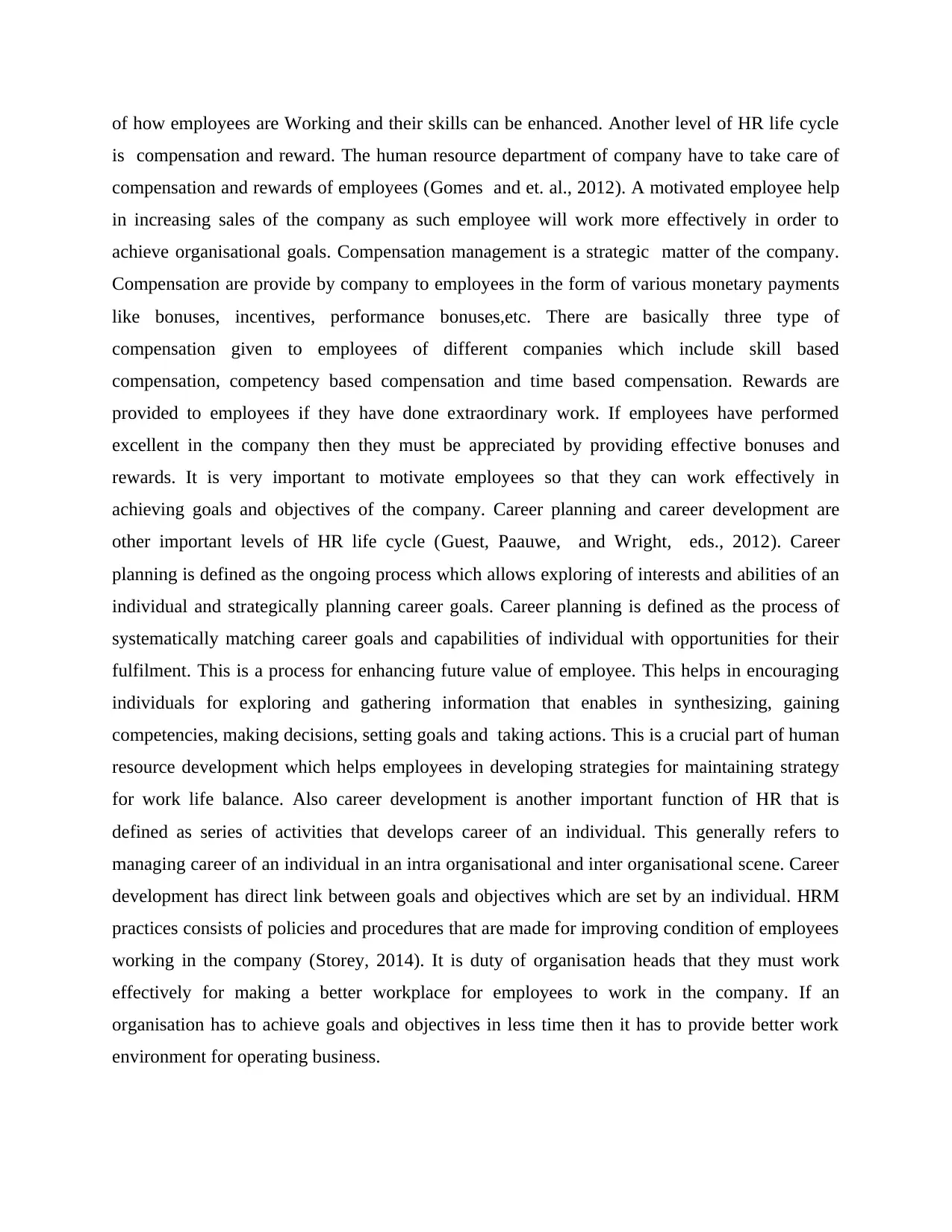
of how employees are Working and their skills can be enhanced. Another level of HR life cycle
is compensation and reward. The human resource department of company have to take care of
compensation and rewards of employees (Gomes and et. al., 2012). A motivated employee help
in increasing sales of the company as such employee will work more effectively in order to
achieve organisational goals. Compensation management is a strategic matter of the company.
Compensation are provide by company to employees in the form of various monetary payments
like bonuses, incentives, performance bonuses,etc. There are basically three type of
compensation given to employees of different companies which include skill based
compensation, competency based compensation and time based compensation. Rewards are
provided to employees if they have done extraordinary work. If employees have performed
excellent in the company then they must be appreciated by providing effective bonuses and
rewards. It is very important to motivate employees so that they can work effectively in
achieving goals and objectives of the company. Career planning and career development are
other important levels of HR life cycle (Guest, Paauwe, and Wright, eds., 2012). Career
planning is defined as the ongoing process which allows exploring of interests and abilities of an
individual and strategically planning career goals. Career planning is defined as the process of
systematically matching career goals and capabilities of individual with opportunities for their
fulfilment. This is a process for enhancing future value of employee. This helps in encouraging
individuals for exploring and gathering information that enables in synthesizing, gaining
competencies, making decisions, setting goals and taking actions. This is a crucial part of human
resource development which helps employees in developing strategies for maintaining strategy
for work life balance. Also career development is another important function of HR that is
defined as series of activities that develops career of an individual. This generally refers to
managing career of an individual in an intra organisational and inter organisational scene. Career
development has direct link between goals and objectives which are set by an individual. HRM
practices consists of policies and procedures that are made for improving condition of employees
working in the company (Storey, 2014). It is duty of organisation heads that they must work
effectively for making a better workplace for employees to work in the company. If an
organisation has to achieve goals and objectives in less time then it has to provide better work
environment for operating business.
is compensation and reward. The human resource department of company have to take care of
compensation and rewards of employees (Gomes and et. al., 2012). A motivated employee help
in increasing sales of the company as such employee will work more effectively in order to
achieve organisational goals. Compensation management is a strategic matter of the company.
Compensation are provide by company to employees in the form of various monetary payments
like bonuses, incentives, performance bonuses,etc. There are basically three type of
compensation given to employees of different companies which include skill based
compensation, competency based compensation and time based compensation. Rewards are
provided to employees if they have done extraordinary work. If employees have performed
excellent in the company then they must be appreciated by providing effective bonuses and
rewards. It is very important to motivate employees so that they can work effectively in
achieving goals and objectives of the company. Career planning and career development are
other important levels of HR life cycle (Guest, Paauwe, and Wright, eds., 2012). Career
planning is defined as the ongoing process which allows exploring of interests and abilities of an
individual and strategically planning career goals. Career planning is defined as the process of
systematically matching career goals and capabilities of individual with opportunities for their
fulfilment. This is a process for enhancing future value of employee. This helps in encouraging
individuals for exploring and gathering information that enables in synthesizing, gaining
competencies, making decisions, setting goals and taking actions. This is a crucial part of human
resource development which helps employees in developing strategies for maintaining strategy
for work life balance. Also career development is another important function of HR that is
defined as series of activities that develops career of an individual. This generally refers to
managing career of an individual in an intra organisational and inter organisational scene. Career
development has direct link between goals and objectives which are set by an individual. HRM
practices consists of policies and procedures that are made for improving condition of employees
working in the company (Storey, 2014). It is duty of organisation heads that they must work
effectively for making a better workplace for employees to work in the company. If an
organisation has to achieve goals and objectives in less time then it has to provide better work
environment for operating business.
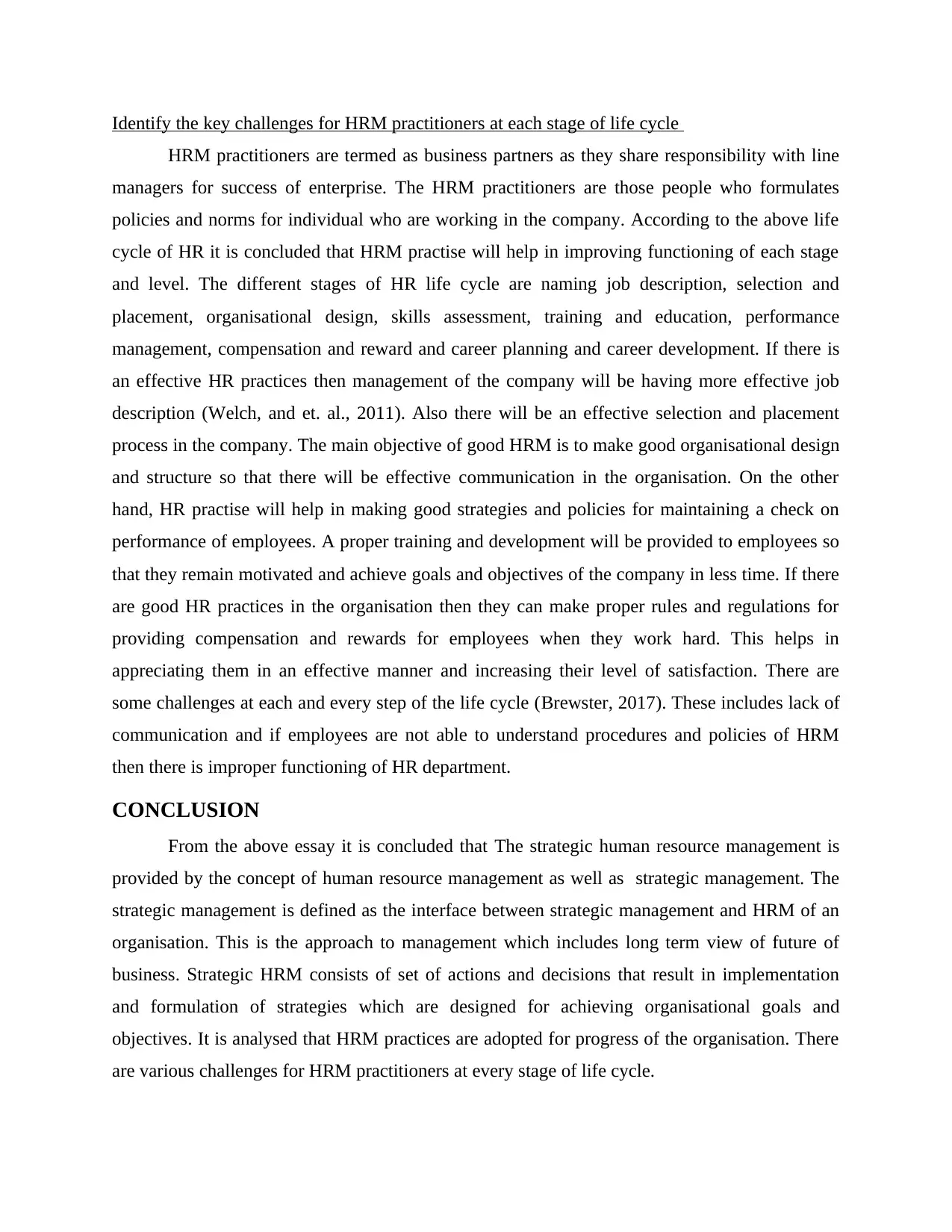
Identify the key challenges for HRM practitioners at each stage of life cycle
HRM practitioners are termed as business partners as they share responsibility with line
managers for success of enterprise. The HRM practitioners are those people who formulates
policies and norms for individual who are working in the company. According to the above life
cycle of HR it is concluded that HRM practise will help in improving functioning of each stage
and level. The different stages of HR life cycle are naming job description, selection and
placement, organisational design, skills assessment, training and education, performance
management, compensation and reward and career planning and career development. If there is
an effective HR practices then management of the company will be having more effective job
description (Welch, and et. al., 2011). Also there will be an effective selection and placement
process in the company. The main objective of good HRM is to make good organisational design
and structure so that there will be effective communication in the organisation. On the other
hand, HR practise will help in making good strategies and policies for maintaining a check on
performance of employees. A proper training and development will be provided to employees so
that they remain motivated and achieve goals and objectives of the company in less time. If there
are good HR practices in the organisation then they can make proper rules and regulations for
providing compensation and rewards for employees when they work hard. This helps in
appreciating them in an effective manner and increasing their level of satisfaction. There are
some challenges at each and every step of the life cycle (Brewster, 2017). These includes lack of
communication and if employees are not able to understand procedures and policies of HRM
then there is improper functioning of HR department.
CONCLUSION
From the above essay it is concluded that The strategic human resource management is
provided by the concept of human resource management as well as strategic management. The
strategic management is defined as the interface between strategic management and HRM of an
organisation. This is the approach to management which includes long term view of future of
business. Strategic HRM consists of set of actions and decisions that result in implementation
and formulation of strategies which are designed for achieving organisational goals and
objectives. It is analysed that HRM practices are adopted for progress of the organisation. There
are various challenges for HRM practitioners at every stage of life cycle.
HRM practitioners are termed as business partners as they share responsibility with line
managers for success of enterprise. The HRM practitioners are those people who formulates
policies and norms for individual who are working in the company. According to the above life
cycle of HR it is concluded that HRM practise will help in improving functioning of each stage
and level. The different stages of HR life cycle are naming job description, selection and
placement, organisational design, skills assessment, training and education, performance
management, compensation and reward and career planning and career development. If there is
an effective HR practices then management of the company will be having more effective job
description (Welch, and et. al., 2011). Also there will be an effective selection and placement
process in the company. The main objective of good HRM is to make good organisational design
and structure so that there will be effective communication in the organisation. On the other
hand, HR practise will help in making good strategies and policies for maintaining a check on
performance of employees. A proper training and development will be provided to employees so
that they remain motivated and achieve goals and objectives of the company in less time. If there
are good HR practices in the organisation then they can make proper rules and regulations for
providing compensation and rewards for employees when they work hard. This helps in
appreciating them in an effective manner and increasing their level of satisfaction. There are
some challenges at each and every step of the life cycle (Brewster, 2017). These includes lack of
communication and if employees are not able to understand procedures and policies of HRM
then there is improper functioning of HR department.
CONCLUSION
From the above essay it is concluded that The strategic human resource management is
provided by the concept of human resource management as well as strategic management. The
strategic management is defined as the interface between strategic management and HRM of an
organisation. This is the approach to management which includes long term view of future of
business. Strategic HRM consists of set of actions and decisions that result in implementation
and formulation of strategies which are designed for achieving organisational goals and
objectives. It is analysed that HRM practices are adopted for progress of the organisation. There
are various challenges for HRM practitioners at every stage of life cycle.
⊘ This is a preview!⊘
Do you want full access?
Subscribe today to unlock all pages.

Trusted by 1+ million students worldwide
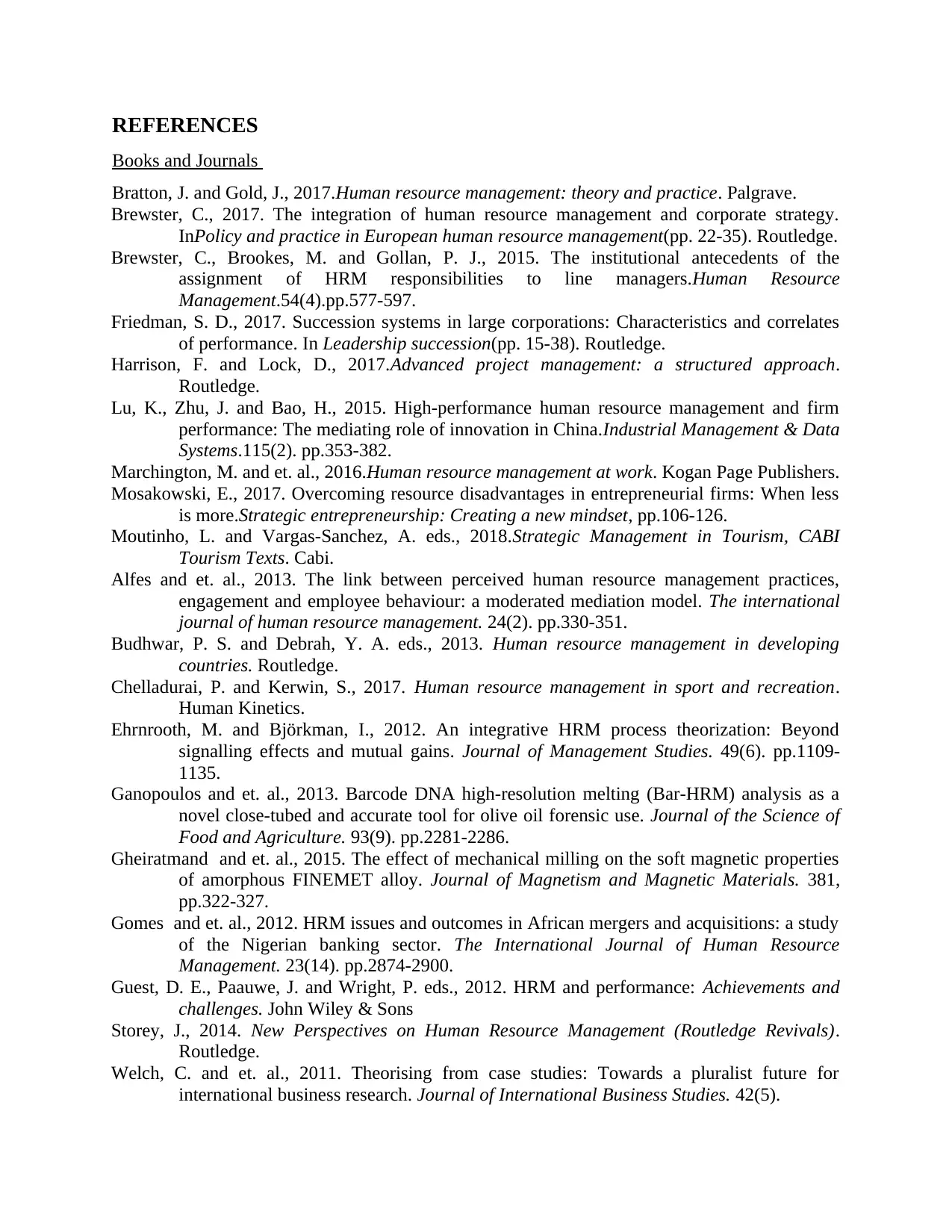
REFERENCES
Books and Journals
Bratton, J. and Gold, J., 2017.Human resource management: theory and practice. Palgrave.
Brewster, C., 2017. The integration of human resource management and corporate strategy.
InPolicy and practice in European human resource management(pp. 22-35). Routledge.
Brewster, C., Brookes, M. and Gollan, P. J., 2015. The institutional antecedents of the
assignment of HRM responsibilities to line managers.Human Resource
Management.54(4).pp.577-597.
Friedman, S. D., 2017. Succession systems in large corporations: Characteristics and correlates
of performance. In Leadership succession(pp. 15-38). Routledge.
Harrison, F. and Lock, D., 2017.Advanced project management: a structured approach.
Routledge.
Lu, K., Zhu, J. and Bao, H., 2015. High-performance human resource management and firm
performance: The mediating role of innovation in China.Industrial Management & Data
Systems.115(2). pp.353-382.
Marchington, M. and et. al., 2016.Human resource management at work. Kogan Page Publishers.
Mosakowski, E., 2017. Overcoming resource disadvantages in entrepreneurial firms: When less
is more.Strategic entrepreneurship: Creating a new mindset, pp.106-126.
Moutinho, L. and Vargas-Sanchez, A. eds., 2018.Strategic Management in Tourism, CABI
Tourism Texts. Cabi.
Alfes and et. al., 2013. The link between perceived human resource management practices,
engagement and employee behaviour: a moderated mediation model. The international
journal of human resource management. 24(2). pp.330-351.
Budhwar, P. S. and Debrah, Y. A. eds., 2013. Human resource management in developing
countries. Routledge.
Chelladurai, P. and Kerwin, S., 2017. Human resource management in sport and recreation.
Human Kinetics.
Ehrnrooth, M. and Björkman, I., 2012. An integrative HRM process theorization: Beyond
signalling effects and mutual gains. Journal of Management Studies. 49(6). pp.1109-
1135.
Ganopoulos and et. al., 2013. Barcode DNA high‐resolution melting (Bar‐HRM) analysis as a
novel close‐tubed and accurate tool for olive oil forensic use. Journal of the Science of
Food and Agriculture. 93(9). pp.2281-2286.
Gheiratmand and et. al., 2015. The effect of mechanical milling on the soft magnetic properties
of amorphous FINEMET alloy. Journal of Magnetism and Magnetic Materials. 381,
pp.322-327.
Gomes and et. al., 2012. HRM issues and outcomes in African mergers and acquisitions: a study
of the Nigerian banking sector. The International Journal of Human Resource
Management. 23(14). pp.2874-2900.
Guest, D. E., Paauwe, J. and Wright, P. eds., 2012. HRM and performance: Achievements and
challenges. John Wiley & Sons
Storey, J., 2014. New Perspectives on Human Resource Management (Routledge Revivals).
Routledge.
Welch, C. and et. al., 2011. Theorising from case studies: Towards a pluralist future for
international business research. Journal of International Business Studies. 42(5).
Books and Journals
Bratton, J. and Gold, J., 2017.Human resource management: theory and practice. Palgrave.
Brewster, C., 2017. The integration of human resource management and corporate strategy.
InPolicy and practice in European human resource management(pp. 22-35). Routledge.
Brewster, C., Brookes, M. and Gollan, P. J., 2015. The institutional antecedents of the
assignment of HRM responsibilities to line managers.Human Resource
Management.54(4).pp.577-597.
Friedman, S. D., 2017. Succession systems in large corporations: Characteristics and correlates
of performance. In Leadership succession(pp. 15-38). Routledge.
Harrison, F. and Lock, D., 2017.Advanced project management: a structured approach.
Routledge.
Lu, K., Zhu, J. and Bao, H., 2015. High-performance human resource management and firm
performance: The mediating role of innovation in China.Industrial Management & Data
Systems.115(2). pp.353-382.
Marchington, M. and et. al., 2016.Human resource management at work. Kogan Page Publishers.
Mosakowski, E., 2017. Overcoming resource disadvantages in entrepreneurial firms: When less
is more.Strategic entrepreneurship: Creating a new mindset, pp.106-126.
Moutinho, L. and Vargas-Sanchez, A. eds., 2018.Strategic Management in Tourism, CABI
Tourism Texts. Cabi.
Alfes and et. al., 2013. The link between perceived human resource management practices,
engagement and employee behaviour: a moderated mediation model. The international
journal of human resource management. 24(2). pp.330-351.
Budhwar, P. S. and Debrah, Y. A. eds., 2013. Human resource management in developing
countries. Routledge.
Chelladurai, P. and Kerwin, S., 2017. Human resource management in sport and recreation.
Human Kinetics.
Ehrnrooth, M. and Björkman, I., 2012. An integrative HRM process theorization: Beyond
signalling effects and mutual gains. Journal of Management Studies. 49(6). pp.1109-
1135.
Ganopoulos and et. al., 2013. Barcode DNA high‐resolution melting (Bar‐HRM) analysis as a
novel close‐tubed and accurate tool for olive oil forensic use. Journal of the Science of
Food and Agriculture. 93(9). pp.2281-2286.
Gheiratmand and et. al., 2015. The effect of mechanical milling on the soft magnetic properties
of amorphous FINEMET alloy. Journal of Magnetism and Magnetic Materials. 381,
pp.322-327.
Gomes and et. al., 2012. HRM issues and outcomes in African mergers and acquisitions: a study
of the Nigerian banking sector. The International Journal of Human Resource
Management. 23(14). pp.2874-2900.
Guest, D. E., Paauwe, J. and Wright, P. eds., 2012. HRM and performance: Achievements and
challenges. John Wiley & Sons
Storey, J., 2014. New Perspectives on Human Resource Management (Routledge Revivals).
Routledge.
Welch, C. and et. al., 2011. Theorising from case studies: Towards a pluralist future for
international business research. Journal of International Business Studies. 42(5).
1 out of 10
Related Documents
Your All-in-One AI-Powered Toolkit for Academic Success.
+13062052269
info@desklib.com
Available 24*7 on WhatsApp / Email
![[object Object]](/_next/static/media/star-bottom.7253800d.svg)
Unlock your academic potential
Copyright © 2020–2025 A2Z Services. All Rights Reserved. Developed and managed by ZUCOL.





